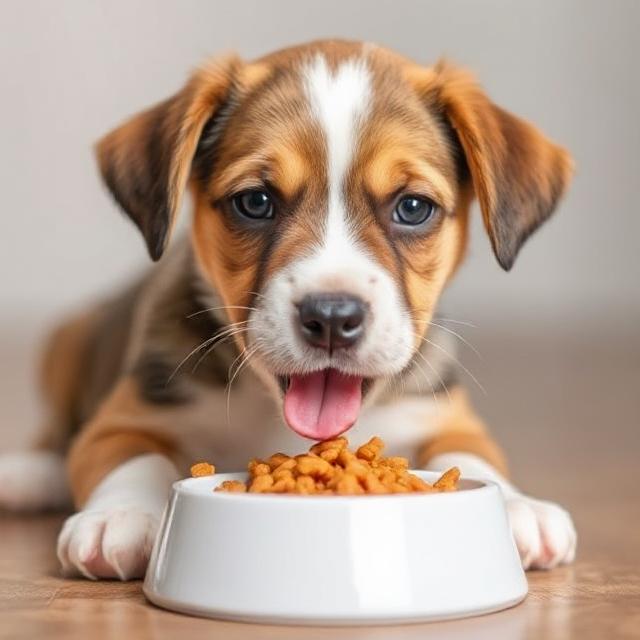What to Do If Puppy Not Eating Food
🐶 What to Do If Puppy Not Eating Food — Complete Guide for Pet Owners
what to do if puppy not eating food. Bringing a new puppy home is one of life’s pure joys — the excitement, the cuddles, and those adorable puppy eyes. But when your playful forkball suddenly stops eating, worry sets in quickly. You may find yourself asking: Why is my puppy not eating? and What should I do?
If your puppy isn’t eating food, it’s important not to panic. There are several possible reasons behind the loss of appetite — some minor and others more serious. In this detailed guide, we’ll cover why your puppy may not be eating, what to do about it, and when it’s time to call the vet.
🦴 1. Understand That Puppies Have Sensitive Appetites
Puppies are just like human babies — their digestive systems are still developing, and they’re easily affected by changes in environment, food, and routine. So, if your puppy skips a meal or two occasionally, it doesn’t always mean something is seriously wrong.
However, if your puppy hasn’t eaten for more than 12–24 hours, it’s time to investigate further. what to do if puppy not eating food
🩺 2. Common Reasons Why a Puppy Might Not Eat
Let’s look at the most common causes of a puppy refusing food: what to do if puppy not eating food
a) Change in Environment
A new home, unfamiliar smells, and different people can make your puppy anxious. This stress often leads to temporary loss of appetite.
What to do:
Give your puppy a few days to adjust. Keep feeding times quiet and consistent, and avoid overwhelming your pet with too much attention or noise during meals.
b) Change in Diet or Food Type
If you recently switched brands or introduced new flavors, your puppy may not like the taste or texture. Some dogs are picky eaters, while others take time to adapt to new food. what to do if puppy not eating food
What to do:
Mix a small amount of the new food with the old one and transition gradually over 7–10 days. This helps the puppy’s digestive system adjust smoothly.
c) Teething Pain
Between 3 and 6 months of age, puppies start teething. Their gums may feel sore, making chewing dry kibble uncomfortable.
What to do:
Soften the food with warm water or broth. You can also try wet puppy food or puppy-safe soft treats until the teething phase passes.
d) Overfeeding or Too Many Treats
Sometimes, the issue isn’t a lack of appetite — it’s simply that the puppy is already full! Too many treats or table scraps can spoil their main meals.
What to do:
Limit treats to training purposes only and follow the 10% rule (treats should make up no more than 10% of total calories). Stick to a proper feeding schedule.
e) Illness or Infection
If your puppy not eating food lasts longer than a day, it might be due to an underlying health issue such as: what to do if puppy not eating food
-
Worms or parasites
-
Stomach infection
-
Dental issues
-
Fever
-
Respiratory infection (if your puppy has a stuffy nose, they can’t smell their food)
What to do:
Check for other symptoms — vomiting, diarrhea, lethargy, coughing, or unusual behavior. If these occur, contact your veterinarian immediately.
🥣 3. How to Encourage a Puppy to Eat
Once you’ve ruled out any serious illness, try these practical feeding tips to tempt your puppy back to their bowl. what to do if puppy not eating food
a) Make the Food More Appetizing
Warm up wet food slightly (never too hot) or add a splash of warm chicken broth to kibble to release delicious aromas. Puppies rely on their sense of smell, and warm food smells more enticing. what to do if puppy not eating food
b) Feed in a Calm Environment
Choose a quiet area away from distractions. Some puppies feel nervous if there’s too much activity around while they eat.
c) Hand-Feeding
Hand-feeding can create a sense of comfort and bonding. Offer small bites directly from your hand to encourage trust and appetite.
d) Stick to a Feeding Schedule
Feed your puppy at the same times every day. Consistency helps them develop good eating habits and digestive regularity.
e) Exercise Before Meals
A short play session or walk can stimulate your puppy’s appetite. Just avoid heavy activity immediately after eating to prevent bloating.
f) Try Different Textures
Some puppies prefer crunchy kibble, others like soft food. Experiment with a mix — for example, half dry and half wet — to find what works best.
🐾 4. When to Worry — Signs It’s Time to Visit the Vet
If your puppy’s lack of appetite comes with any of the following symptoms, don’t wait — seek veterinary help right away:
-
Vomiting or diarrhea lasting more than 12 hours
-
Refusal to drink water
-
Sudden weight loss or weakness
-
Coughing, sneezing, or nasal discharge
-
Swollen abdomen or bloating
-
Pale gums or signs of pain
Remember: Puppies are delicate. Even a small issue can escalate quickly. It’s always better to get a professional opinion early rather than later.
🍗 5. Healthy Feeding Habits for Growing Puppies
To prevent feeding problems in the future, it’s crucial to build healthy eating routines from the start. what to do if puppy not eating food
a) Choose the Right Puppy Food
Look for food labeled “Complete and Balanced for Puppies” by reputable brands. Avoid adult dog food, as it doesn’t provide the right nutrients for growth.
b) Follow Proper Portion Sizes
Overfeeding can lead to obesity and digestive upset, while underfeeding can stunt growth. Check the feeding chart on the food packaging based on your puppy’s weight and age.
c) Keep Fresh Water Available
Hydration is just as important as food. Always provide clean, fresh water — and check that your puppy drinks regularly.
d) Avoid Human Foods
Some human foods like chocolate, onions, grapes, and even too much dairy can be toxic to dogs. Stick to vet-approved dog treats only.
e) Monitor Eating Patterns
Keep track of your puppy’s eating schedule and appetite. Noticing changes early can help catch health issues before they worsen.
💡 6. Natural Appetite Boosters (Vet-Approved)
If your puppy is healthy but just a little fussy, you can safely try these natural methods to boost appetite: what to do if puppy not eating food
-
Add a spoon of plain yogurt (for probiotics and taste)
-
Mix a little wet food with dry kibble
-
Use bone broth (unsalted and onion-free)
-
Offer small frequent meals instead of large portions
-
Feed after playtime when energy is spent
Always introduce new items gradually and observe how your puppy responds. what to do if puppy not eating food
🐕 7. Emotional and Behavioral Factors
Not all feeding issues are physical. Sometimes, emotional changes or behavioral stress can cause your puppy to go off food.
-
Loneliness: Puppies recently separated from their littermates may feel anxious.
-
Separation anxiety: If they refuse to eat when left alone, it’s likely emotional.
-
Dominance issues: In multi-dog homes, a shy puppy might not eat around others.
Solution: Give your puppy personal feeding space, spend quality time together, and provide comfort toys or blankets that smell familiar.
❤️ Final Thoughts
A puppy refusing food can be worrying, but it’s often temporary and fixable. The key is to stay calm, observe carefully, and take gentle steps to reintroduce food while ruling out medical problems. what to do if puppy not eating food
If your puppy hasn’t eaten in 24 hours, is showing other symptoms, or if your instincts tell you something isn’t right — don’t hesitate to contact your vet. Early care ensures your furry friend gets back to wagging their tail and enjoying their meals in no time!
📋 Quick Summary: What to Do If Puppy Not Eating Food
| Step | Action |
|---|---|
| 1 | Check for environmental or dietary changes |
| 2 | Rule out illness (look for symptoms) |
| 3 | Offer warm, appetizing food |
| 4 | Feed in a quiet, calm environment |
| 5 | Maintain routine and hydration |
| 6 | Contact a vet if no improvement within 24 hours |


